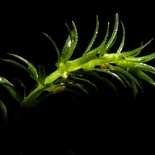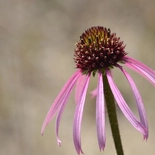To further Wild Ones’ mission to connect people and native plants, we are excited to continue this monthly blog focused on native plants in the national news. This regular feature aims to educate, engage, and inspire action by spotlighting conservation issues and scientific findings related to native flora.
New England: Forty Years of Saving an Orchid Species
The New England region has around 70 species of wild orchids, some rare, and many are threatened by poachers, habitat loss, and climate change. This includes the small whorled pogonia (Isotria medeoloides). There are only about 3,000 left in the world and Maine and New Hampshire have the largest populations. Vermont’s one population was rediscovered in 2022 with a total of nine plants.

Small Whorled Pogonia(Isotria medeoloides)
One small whorled pogonia population was discovered in 1982 and it’s been monitored since 1986. Experts experimented with the location conditions, such as thinning the forest canopy, to see if that helped populations grow and the number of orchids growing in the test plot more than doubled. However, experts are not sure whether it’s due to increased sunlight or potentially altering the underground fungus that contributes to the orchid’s survival. This plant can remain dormant for up to 10 years so results are slow to come in.
This experiment also raised questions on how much researchers should intervene to save these plants. “I think we’re really aware of that line. It’s different for every species and every location. We would like for these plants to have management enough so that they can reproduce on their own irrespective of our intervention,” director of conservation at the Native Plant Trust, Michael Piantedosi said.
Worldwide, there are 30,000 orchid species and about half of those species are threatened. Since orchids are usually specifically adapted to their habitats, they are very sensitive to environments. This makes them particularly vulnerable to climate change, soil degradation, disease, and invasive species.
Inside a 40-year effort to protect a tiny wild orchid – WBUR.org
Georgia: Rescuing native plants from development
In the face of rapid and expanding human development, volunteers with the Georgia Native Plant Society participate in Plant Rescue, a program that saves plants from being lost to developer bulldozers. The purpose of this program is to relocate native plants currently on sites slated for development and move these plants to a safe, appropriate native habitat which include native restoration sites, parks, nature centers, public gardens, plant sales, and backyard habitat.
Plant Rescue, which began in the mid-1990s as metro Atlanta development increased, is possible through many hours of volunteer labor and community effort as well as developer permission. These projects have also included rescuing the hooded pitcher plant (Sarracenia minor): an important pollinator plant whose populations are declining due to habitat destruction, poaching, and commercial exploitation. The Georgia Department of Natural Resources and the Georgia Department of Transportation contacted the Georgia Native Plant Society to rescue these plants that would otherwise be lost to a road widening project. Over 400 pitcher plants were rescued by Plant Rescue and moved to a conservation area as well as a nearby state park and wildlife management area.

Hooded Pitcherplant(Sarracenia minor)
Plant Rescue volunteers not only do important conservation work, they are also learning plant identification, how to properly remove and care for plants, and how to negotiate with landowners for the plant’s removal. Plant Rescue is open to Georgia Native Plant Society members and the more volunteers that get involved, the more plants can be saved. Jeane Reeves, founder of the program, said “Sadly we can’t rescue everything, but if we could gather as many plants as possible and find them some different earth before they are destroyed is such a critical mission.”
Reaping the Rewards of Plant Rescue – Saporta Report
Georgia: Restocking a Dead Lake
Three decades ago, the invasive non-native Hydrilla sp. was introduced into Clarks Hill Lake, likely through boaters or through other contaminated lakes. This noxious plant contains toxic bacteria and as waterfowl ate the leaves, the toxin bioaccumulated up the food chain to bald eagles, causing over 50 deaths of eagles and eaglets. Wildlife experts released carp into the lake to eat the Hydrilla which worked, and eagles are making a comeback at the lake. Unfortunately, the carp ate all the native plants.

Hydrilla(Hydrilla spp.)
This month, the Georgia Department of Natural Resources, the U.S. Army Corps of Engineers and volunteers planted more than 5,000 native water willow, bald cypress, and American lotus plants which should survive the carp. Aaron Gray, a fisheries biologist with Georgia DNR said “There’s a lot of benefits to having these plants back in. It improves the habitat and improves survival of the fish, and then also improves shoreline erosion. That’s another big concern out here in Clarks Hill.” The DNR and the Corps of Engineers plan on doing this every year in the late spring and summer.
Thousands of native plants getting planted in Clarks Hill Lake – WJBF.com
Hawaii: Non-native species hogging the space
Pigs were introduced to Hawaii initially by Native Hawaiians from Polynesia between 400 and 1100, and later by European explorers, including Captain James Cook in the 18th century, leading to a robust feral pig population. These feral pigs damage infrastructure, uproot plants, and may be helping non-native plants establish in Hawaii.
In a study published in Functional Ecology (December 2023), Michael Peyton and co-authors found that areas with more feral pig disturbances had a larger abundance of non-native plants. Researchers set up trail cameras in different parts of the Pu’u O Umi Natural Area Reserve to confirm pig and understory plant species abundances. Plant species were categorized on whether plants produced short-lived leaves with rapid growth or hardier, long-lived leaves with slower growth rates. The authors found that areas with more pig disturbance had more plants with the short-lived leaves and rapid growth associated with non-native plant species. Peyton speculates that the increased sunlight availability in disturbed sites may be a reason these non-natives fast-growing species would do better than the slower-growing natives.
Feral pigs may usher nonnative plants into Hawaii – The Wildlife Society
Tallgrass Prairie Returns to Iowa
According to the U.S. Fish and Wildlife Service, 99% of tallgrass prairie has been converted into farmland, making this ecosystem one of the most endangered ecosystems in North America. Nowhere is this dire statistic more obvious than in Iowa.
A college in Iowa decided to reestablish some of Iowa’s former glory. Luther College has restored several former farm sites after the college purchased land from the Jewell family almost a century ago. After the land flooded in 2008, it was converted to Jewell Prairie and seeded in the fall of 2011. Molly McNicoll, a Luther College professor overseeing the restoration explained that prairie grasses, sedges, and wildflowers have deep root systems, which mitigate flooding by absorbing river sediment into the soil. These species hold the soil in place instead of eroding away.
After over 12 years, Luther professor Kirk Larson and students have discovered 97 native bee species, an astounding number, confirming that the college’s efforts to plant pollinator plants on campus and the prairies was working. Prescribed burning techniques and their effectiveness for prairie restoration are also being studied. The prairie was not burned for the first four years, and starting in 2016, one-third of the prairie was burned at a time. Student, Josie Meyer, who studied the relationship between prairie burns and plant species found increases in plant species diversity, including species found in high-quality sites such as golden alexander (Zizia aurea) and pale purple coneflower (Echinacea pallida). Her research findings set recommendations for specific species management and will be used to guide future prairie development plans.

Golden Zizia(Zizia aurea)

Pale Purple Coneflower(Echinacea pallida)
Luther College’s project has been successful but “you can’t just restore a prairie in one seeding event. It’s a continual process. Part of that is the research the students have been doing,” said McNicoll. “Jewel Prairie has not reached ‘remnant-like diversity’ yet, but it’s well on its way.”
California: Methuselah of Oak Trees
A 13,000-year-old oak, around since the last ice age, is the barrier to a new 370-acre development.

Palmer Oak(Quercus palmeri)
The age of the Palmer oak (Quercus palmeri), which looks more like a shrub than a standard oak tree, was determined by Mitchell Provance, a botanist at the University of California-Davis, and colleagues by measuring the grove’s diameter. At 80 feet wide, this led researchers to estimate the tree’s age between 13,000 and 18,000 years old.
Developers have been trying to develop the area since the early 1990s. The proposed development would come within 400 feet of the tree. The company has worked with an environmental consultant, to study the impact of construction on the tree. However, the tree’s root systems and confirmed water source, have not yet been determined. There is also concern among opponents that the oak would be exposed to the urban heat island effect in which developed areas run 1-7 degrees higher than natural areas.
Local Native American tribes, the Shiishongna Tongva Nation, the Corona Band of Gabrieleño Indians and the Kizh Nation, Gabrieleño Band of Mission Indians, who have lived in the Santa Ana River Basin around as long as the tree has been there, regard it as sacred.
The developer, Richland Communities, said at the public meeting that they reached an agreement in concept to transfer the land to the Kizh Nation and provide them $250,000 for conservation but commissioners want additional information on the plan’s details and how conservation of the land would be enforced.
One of Earth’s oldest known plants takes center stage in California development battle – LA Times
Colorado: Buckley Space Force Base Supports Monarch Butterfly Migration
Thousands of Monarch butterflies are migrating across North America, passing through Colorado. Buckley Space Force Base is crucial in ensuring their journey’s success by restoring nearly 1,000 acres of shortgrass prairie with native nectar-rich plants and milkweed species.
The Department of Defense is deploying wildlife biologists to monitor and restore habitats, addressing the 90% decline in Monarch populations due to habitat loss. They are partnering with Monarch Joint Venture and Monarch Watch to implement monitoring and tagging programs.
“Monarch butterflies are an important indicator species for the health of our environment,” said Veronica Reed, Buckley’s U.S. Fish and Wildlife Biologist. Conservation efforts at Buckley showcase how partnerships can protect our natural heritage and support the inspiring Monarch migration.
Buckley Space Force Base to help Monarch butterfly migration – koaa.com
Washington: Finding a foil to milfoil
The invasive non-native species Eurasian watermilfoil (Myriophyllum spicatum) has been found now in Orcas Island’s Cascade Lake, a water source for hundreds of households as well as a favorite recreation sport. Once established, milfoil spreads quickly, forming dense mats and shading out native vegetation and putting the whole ecosystem at risk. Fishing, swimming, and boating also is impacted by milfoil infestations.

Eurasian Watermilfoil(Myriophyllum spicatum)
The milfoil invader was discovered during a 2023 biological survey by the Washington Department of Ecology, the first since 1997. To control milfoil, several methods exist: physical removal, public education, biological controls, and chemical herbicides. The best way to contain milfoil is to prevent its introduction into freshwater lakes: the plant spreads easily from lake to lake on the hulls of boats, motors, fishing tackle, and footgear. “Any tiny fragment immediately grows into another plant,” said Jason Ontjes of the San Juan Count noxious weed control program. Whatcom County sponsors a public education and invasive species boat inspection program, the best preventative control since other invasive species such as zebra and quagga mussels spread by hitchhiking as well. The herbicide, ProsellaCOR (florpyrauxifen-benzyl) is effective in controlling milfoil but while current data shows little to no issue to human health, public concern exists about herbicide use in the drinking water on which nearly 500 households rely.

